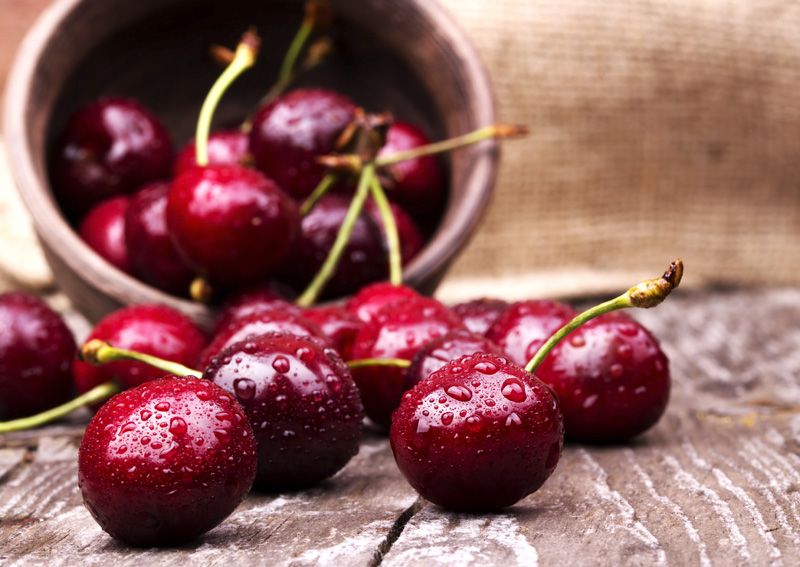Growing Cherries
Cherries are often grown by gardeners for two reasons: they like delicious cherries fruit, and the other grow for pink and white blossoms in the spring season. By following our guide, you can increase your cherries in your garden.
Health Benefits
- There are 3 grams of fiber in one cup of cherries that will be great for your digestive health.
- Eating cherries decrease the risk of colon cancer.
- Eating cherries helps you in weight loss because they are low in calories.
- Another key feature is that they are anti-inflammatory and anti-gout.
- Cherries not only feed your stomach but your brain too!
- Cherries contain natural fructose, which is believed to quicken the metabolism of alcohol in the body.
- Cherries help your muscles to bounce back after a workout.
- Cherries help us to regulate our sleep.
Planting Cheery trees
Choose the Site
Cherries need full light, space, air circulation, and an adequate water supply to thrive. Sandy soft soils with good depth are best for dwarf cherry trees. Heavier soils are not suitable to plant because they tend to become waterlogged put the dwarf trees at risk for pests and diseases.
Planting
The time of planting is late fall to early spring. To plant a standard size tree dig a hole twice the diameter of the root ball and 2 feet deep. Then, we put in a lot of compost that loosened the soil because the roots need to move out quickly to survive the winter. Cherries like slightly acidic soil of 6pH. Fertilize your plants early in the spring when they set flowers and in the fall.
Watering Cherries
After planting your cherry tree, you need to water your plant every day of the first week; in the second and third week, water your plants 2 to 3 times. Provide an adequate amount of water in the upcoming weeks.
Care
Water Maintenance
Water constantly, observing dry places. Keep the soil moist, but don’t overwater it.
Remove Diseased Branches
Any branches taken up by bacterial cankers (a rough black growth also known as a ”black knot”) or brown rot (a light brown fuzz that appears on the skin of cherries) should be pruned immediately to prevent the spores from growing. Wash the pruning shears thoroughly after use.
Control Weeds
Mulching around the base of the trees helps control weeds and keep the soil moist.
Practice planting with partners. The partner plantation can attract pollinators and deter pests like aphids.
Prune and Fertilize
Prune trees at the end of winter and fertilize in the spring. Once the trees start to bear fruit, switch to light fertilization after harvest.
Hunt the Birds
Cover the trees with a light bird net to protect the fruit.
Harvesting Cherries
Fruit crops and patience go hand in hand. Cherry trees take about three years to establish and may begin to bear fruit in the fourth year. Most fruit crops don’t produce the same year you plant them, but once you start bearing fruit, you can continue to do so for years – a mature cherry tree can produce 30-50 kg of fruit in one season.
Cherries are ready when they are deeply colored; depending on the variety, deep red, golden yellow or almost black, and firm, with a bit of springiness. To harvest, use pruning shears to cut the fruit by the stems rather than pulling (and potentially damaging) the fruit.
Pests, Disease and Management
- Bacterial canker(Pseudomonas syringae).
Bacterial canker is found at the bases of branches, twigs, buds, leaves, and fruit. The most conspicuous symptoms are sunken patches on the trunk and branches. Other signs of bacterial canker include cankers, gum exudation, and dieback of clasped branches.
Management
Ensure to use a resistant cherry variety according to your location and environmental conditions.
Don’t plant a new plant near an infected plant, which is the primary source of bacteria.
Replace the infected branch with a healthy one by pruning. Make sure to sterilize your pruning equipment after successful pruning.
- Black knot(Apiosporin morbid).
Black Knot disease is commonly found in plants of genus Prunus. Black knot is easily recognized by its characteristics black tar-like swelling or galls that occur on branches of infected plants. Initially, the gall is inconspicuous swelling, but it increases in size, eventually, raptures becoming hard and black. Galls can also occur at branch junctions or on structural limbs.
Management
The primary method for managing black knots is rigorous pruning destruction of infected material. This process is done in winter when the pathogens are in the dormant stage.
- Brown rot(Monilinia fructicola).
Brown rot first appears in spring as blossoms and leaves become infected and cause browning and wilting. The fungus needs 5 to 6 hours of wetness with 60-70 f temperature to infect cherry trees. Once the blossoms and leaves are infected, the fungus can progress down into the tree and cause twig blights or cankers. Once the tree is infected, the fungus produces asexual spores that will continue to reinfect the tree and can cause rot on the fruit.
Management
The treatment of the disease-resistant cultivars can be incorporated and apply appropriate fungicides for controlling the pathogen, pruning out infected twigs, fruits, and blossoms also essential to stop the spread of the disease.
- Black cherry aphids(Myzus cerasi).
The aphids suck the sap of cherry tree leaves causes the leaves to curl at the top of the branches. The black cherry aphid hibernates in winter as an egg on the tree. They hatch in April as a non-winged aphid. In June, the winged aphid flies away to the host plant. The leaves are so affected by the aphids that the leaves are soaked in honeydew.
Management
The first step to make the tree aphid-free is removing the aphid-covered parts. You can use ladybugs as natural predators to kill aphids. Spraying a homemade pesticide is also very helpful in controlling aphids.

